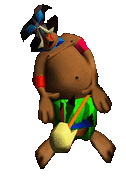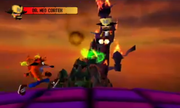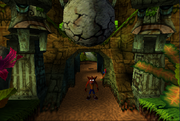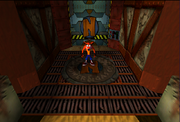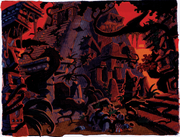Template:Good Article Award
Crash Bandicoot (Japanese: クラッシュ・バンディクー) is a platform game made by Naughty Dog in 1996 for the PlayStation, featuring the character by the same name. While playing, Crash Bandicoot must fight Doctor Neo Cortex and his henchmen in order to save Tawna, his beloved bandicoot girlfriend, from Cortex. This game was made when Naughty Dog had only ten employees. As well as being originally released on the PlayStation, it was also emulated on the PlayStation Network on December 4, 2006, through which it can be played on the PlayStation Portable, Playstation Vita and, as of Operating System update 1.70, on the PlayStation 3. It has sold 6.82 million copies globally.
Gameplay
The gameplay in Crash Bandicoot is noticeably simpler than the series' later iterations. Crash doesn't learn any skills throughout the game, he is able only to jump and use a spin attack. The only animal that Crash can ride in this game is a warthog, which was re-used in the next 2 Crash games.
Levels
There are three Islands on the game, between which 33 levels are divided as follows (the six boss levels are indicated in bold):
| Island | Level Type | Level | Items | Enemies/Obstacles |
|---|---|---|---|---|
| N. Sanity Island | Beach/Jungle | N. Sanity Beach | Clear Gem | Crab; Turtle; Pit |
| Jungle | Jungle Rollers | Clear Gem | Rolling Stone; Skunk; Venus Fly Trap | |
| Native Village Wall | The Great Gate | Clear Gem | Flame; Rolling Monkey; Shield Native; Spiked Pillar; Turtle; Venus Fly Trap | |
| Boulder Chase | Boulders | Clear Gem | Boulder; Pit | |
| River | Upstream | Clear Gem | Flying Fish; Venus Fly Trap | |
| Boss/Native Village Hut | Papu Papu | N/A | Papu Papu boss 1; Papu's Scepter | |
| Jungle | Rolling Stones | Clear Gem | Rolling Stones; Skunk, Turtle; Venus Fly Trap | |
| Hog | Hog Wild | Clear Gem | Shield Native 2; Spiked Pole; Pit | |
| Native Village Wall | Native Fortress | Clear Gem | Flame; Rolling Monkey; Shield Native; Spiked Pole; Turtle; Venus Fly Trap | |
| Wumpa Island | River | Up the Creek | Clear Gem | Flying Fish; Venus Fly Trap; Rolling Monkey |
| Boss/Waterfall | Ripper Roo | N/A | Ripper Roo boss 2; Water; Big TNT | |
| Ancicent Ruins | The Lost City | Green Gem | Bats; Flame; Lizard; Sliding Pillar | |
| Dark Temple | Temple Ruins | Clear Gem | Bats; Closing Pillar; Flame; Snake; Spear; Spider | |
| Bridge | Road to Nowhere | Clear Gem | Hog; Turtle | |
| Boulder Chase | Boulder Dash | Clear Gem | Boulder; Venus Fly Trap | |
| Hog | Whole Hog (requires key) | Clear Gem | Shield Native 2; Spiked Pole | |
| Ancicent Ruins | Sunset Vista | Clear Gem, Key | Bats; Flame; Lizard; Sliding Pillar | |
| Boss/Mines | Koala Kong | N/A | Koala Kong boss 3, TNT, Boulders | |
| Cortex Island | Factory | Heavy Machinery | Clear Gem | Holoprojector; Pipe; Steam Pipe; Hovering Robot; Spiked Robot; Crawling |
| Electric Pipes | Cortex Power | Clear Gem | Electric Orb; Electric Pipe; Machine Gunner; Robot; Slime | |
| Powering Station | Generator Room | Orange Gem | Holoprojector; Power Pipe; Television Screen; Steam Pipe; Spiked Robot | |
| Toxic Plant | Toxic Waste | Blue Gem | Barrel Thrower; Bouncing Toxic Waste Barrel; Waste Barrel; Slime | |
| Boss/Office | Pinstripe Potoroo | N/A | Pinstripe Potoroo boss 4; Machine Gun bullets | |
| Bridge | The High Road | Clear Gem | Hog; Turtle | |
| Castle Exterior | Slippery Climb | Red Gem | Bird; Evil Hand; Lab Assistant; Spike; Stairs | |
| Dark Hall Way | Lights Out | Purple Gem | Rat; Swinging Blade | |
| Dark Hall Way | Fumbling in the Dark (requires key) | Clear Gem | Rat; Swinging Blade;Spider; Deadly Spider | |
| Dark Temple | Jaws of Darkness | Clear Gem, Key | Bats 2; Closing Pillar; Flame; Snake; Spear; Spider | |
| Factory | Castle Machinery | Clear Gem | Pipe; Holoprojector; Robot; Steam Pipe | |
| Boss/Potions Room | Dr. Nitrus Brio | N/A | Dr. Nitrus Brio boss 5; Deadly Potions | |
| Castle Interior | The Lab | Yellow Gem | Blob; Electric Pillar; Lab Assistant | |
| Pent House | The Great Hall | N/A | N/A | |
| Boss/Airship | Dr. Neo Cortex | N/A | Dr. Neo Cortex boss 6; Laser Zapper | |
| Cancelled Level | Castle Exterior | Stormy Ascent | Clear Gem | Birds; Evil Hand; Lab Assistant; Spike; Stairs |
Crates and other items
- Outline crate
- Crash crate
- Iron crate
- Arrow crate
- Basic crate
- Checkpoint crate
- Aku Aku crate
- TNT crate
- ! crate
- Bounce crate
- ? crate
- Gems
- Keys
- Wumpa fruit
Story
Template:Spoilers
Cortex (right) and Brio (left) put Crash under the Evolvo-Ray
Somewhere southeast of Australia, rest three little islands, teeming with wildlife. Two humans however, have been experimenting with the local furry creatures, in order to form a destructive and evil army of mutants. Doctor Nitrus Brio creates a machine called the Evolvo-Ray, an invention capable of turning animals anthropomorphic, but his ever pushy employer (and main series antagonist) takes the credit. One night in his castle, Doctor Neo Cortex has just captured two bandicoots; one male and one female. They are both put under the Evolvo-Ray and both work successfully. Dr. Cortex plans to make the male the leader of his Cortex Commandos for world domination and inserts the evolved male (Crash) into his patented Cortex Vortex, a mind-controlling device designed to brainwash mammals and turn them into evil henchmen, even though Dr. Brio warns Cortex that the Vortex is not ready. Crash turns out to be an utter failure and is rejected by the Vortex. Crash is chased by Cortex throughout the lab, who is attempting to catch him, but the marsupial accidentally breaks through a window and falls into the sea, but Tawna (the female bandicoot and his girlfriend) is still in Cortex's clutches. Crash washes up on the beach of his home island, having survived the fall, and sets out to save Tawna before Cortex can do anything terrible to her.
Knowing full aware that Crash will come back for Tawna, Cortex sends out his best henchmen (one of them also being a failed experiment) to stop him.
Crash and Tawna finally together.
Cortex's plan, however is foiled when Crash eventually reaches his toxic waste factory and shuts it down when battling the C.E.O. and Cortex's bodyguard, Pinstripe. Crash soon enters Cortex's sinister castle. He confronts N. Brio in his lab room, where the mad doctor drinks a potion and turns into a monster pounding the ground, which causes the castle to go up in flames.
With his plans ruined, Cortex faces Crash atop his airship. After a long fight, Crash watches in awe as the rocket platform that Cortex stands on explodes, and Cortex apparently falls to his death. Crash is finally reunited with his beloved Tawna. The couple take the airship and fly into the sunset.
Little does Crash know that Cortex will return.
Alternate ending
The alternate ending
Instead of the other ending being the true ending or an extension like in other games of the series, the first game has a different ending entirely, an alternate ending if you collect all the Gems and take the new route in The Great Hall. Here, Crash finds Tawna in the castle, but does not fight Dr. Cortex. Crash and Tawna escape together on a friendly bird, and many stories are told of the bosses.
Papu Papu started a Big & Tall Shop using money he received by selling Cortex Castle to a resort developer.
Ripper Roo received intense therapy and a few years of higher education, and wrote the book "Through the Eyes of the Vortex" which talks about rapid evolution.
Koala Kong moved to Hollywood, started an acting career, and is working with a speech therapist.
Pinstripe moved to Chicago and started a sanitation company.
Dr. N. Brio revisited his earlier hobby of bar tending.
Curiously, the epilogue mentioned that Cortex disappeared. This may be due to Crash apparently never fighting him, thus he never accidentally rediscovered the Crystals in the sequel. Obviously, Crash Bandicoot 2: Cortex Strikes Back shows Cortex's fall from the original ending, though that doesn't mean that the other characters didn't receive their closure. For example, "Dr. Roo" is mildly referenced in the sequel, and Papu Papu and Pinstripe weren't even seen until Crash Team Racing. Template:Spoiler over
Characters
The characters of CB.left to right: Aku Aku, Papu Papu, Ripper Roo, Pinstripe, Koala Kong, Tawna, Crash, Dr. Neo Cortex and Dr. Nitrus Brio.
All of the characters were voiced by Brendan O'Brien.
Crash Bandicoot: The hero of the game. Once just an ordinary bandicoot taken from his home by the evil Dr. Cortex to be the general of his Cortex Commandos for world domination. Crash gained his jump and spin attack from the Evolvo-Ray. But when he was raised into the Cortex Vortex, to become evil, he was rejected by the machine and gets chased by an angry Cortex. Although Crash escapes by jumping out the window, he left Tawna (his bandicoot girlfriend) in the hands of Cortex's hench men, so he sets out on a long adventure to save her.
Aku Aku: Crash's best friend. He is a magical mask who protects him from enemies. He is first seen on N. Sanity Beach in special crates. He helps Crash on his quest and wants to stop Cortex himself. Aku Aku does not speak in this game.
Doctor Neo Cortex: The main antagonist. Cortex was mocked and ridiculed by people, so he sought revenge against humanity by making an army of monsters he called Cortex Commandos and take over the world. He then joined with another mad scientist, Dr. Nitrus Brio and told him to make a machine called the Evolvo-Ray along with the Cortex Vortex. When N. Brio finished Cortex stole the credit and because of his low self-esteem, Brio didn't say anything. Together, they begun messing with the island's ecosystem turning animals and plants into mutants. It seemed like Cortex's plan was going well. . . until Crash was made.
Doctor Nitrus Brio: A supporting villain. Being his bosses assistant led to some rivalry and it was actually N. Brio that made the Evolvo-Ray but his low self-esteem let Cortex take the credit. He seems to be obsessed with potions and vials. He stutters frequently and is nervous about what he's doing.
Tawna: A female bandicoot who was Crash's girlfriend at the time. She is another bandicoot Cortex tried to evolve and mutate. She is also the sole purpose Crash goes on his journey.
Pinstripe Potoroo: A mafia-style, fancy dressed, mutated potoroo armed with a Tommy-Gun and a maniacal laugh. Pinstripe was in charge of the radioactive Cortex Power on Cortex Island and even had an office. It is possible that after his boss fight when he shoots the reactor at the back it stops pollution going into the sea, it could also be one of the reasons the castle catches fire.
Ripper Roo: A perfect example of an experiment gone wrong. This was Cortex's first test subject and it shows, unfortunately he had one too many shots from the Cortex Vortex resulting in an insane kangaroo with a straight-jacket and crazy eyes. His fight with Crash took place at the top of the waterfall on the second island where he was probably sent to stay.
Papu Papu: The fat leader of the tribesmen on N. Sanity Island. He is the only boss who was not working for Cortex. He only tried to kill Crash because he got woken up from his nap.
Koala Kong: A mutated koala bear who has enough build on him to be a bodyguard. Despite how big he is, he is not the brightest mutant as shown in his boss fight where he is showing off his moves giving Crash time to spin a boulder at him.
Analysis
Crash Bandicoot is notable for its rich themes and subtexts, which show the influence of Eastern philosophy as well as ideology of the Elizabethan era.
The game largely deals with balance, harmony and the natural order. These concepts are embodied in the duality present throughout the game; good and evil, natural and man-made, intelligence and physical strength, emotion and logic. The setting also reflects this, with many level types appearing twice. Opposites, according to the game, are meant to be in balance. The narrative serves as an exploration of what happens when harmony is disrupted.
The primary conflict of the game is the disturbance of this balance by Cortex, whose desire for power and control lead him to act against the natural order. Formerly balanced between good and evil, he is driven to madness by his suffering at the hands of fellow scientists. Now almost entirely evil, he spreads his imbalance to the people and places he comes in contact with. His foil Brio for instance, becomes servile to Cortex, rather than an evenly matched rival. Cortex’s enterprise rains down destruction on the islands, through pollution and tampering with nature, creating a decaying dystopia with him at the throne. This disruption of the natural order leads to the creation of Crash. Although intended by Cortex to be an instrument of further destruction, he serves as a means for the natural order to restore itself. When an evil entity is introduced, a good one soon follows. Inevitably, the two opposites meet and balance is restored.
Crash Bandicoot may function as a tragedy in the Shakespearean sense. By this understanding, Cortex serves as the tragic hero. Although only his fall is shown during the course of the game, he was once a respected intellectual. The turning point for him came when his newest theories were ridiculed, despite their accuracy. This drove him to seek revenge at the cost of his humanity. In this sense, Cortex is the victim. His “evil plan” is merely his own attempt to restore balance by exacting his revenge on those that first attacked him. The restoration of the natural order through the confrontation of Crash and Cortex provides Catharsis. In the end, Cortex fails, and is left with nothing. Crash, the instrument of the natural order, restores balance, but in doing so loses his innocence. Like Cortex, he comes out a different person, unable to return to his natural, animal state despite having done nothing wrong.
The themes of the game are conveyed not just through the action, but through symbolism as well. Aku Aku is the embodiment of the natural order, aiding Crash in his efforts to restore balance. Conversely, the Cortex Vortex represents the disruption of balance by Cortex. In far eastern mythology, the shell of a turtle represents heaven while its underside represents earth. The appearance of turtles upside down in the game symbolizes the disorder and chaos Cortex has caused in the natural order. The TNT crates foreshadow the events of the game, with the countdown from three to one representing the journey across the three islands and the explosion representing the confrontation between Crash and Cortex and violent restoration of balance. The Wumpa Islands themselves are important symbols. They represent the three acts of the game: the beginning, middle, and end. The islands also reflect the changing mindset of Crash and the destruction of his innocence, first shown to be benign and tranquil, but becoming dark and threatening as time goes on. Each island also presents a different form of civilization. The first is primitive and the only one that lives harmoniously with nature. Consequently, it is the only one shown to be healthy and strong. The second civilization has failed long ago, its existence is only hinted at through the ruins it has left behind. It seems to have been mighty, but ultimately failed and has been taken over by the forest. The third civilization is that of Cortex. This, too, is mighty, but works against nature, which leads to its downfall. The events on the third island reveal to the player that the civilization failed because it went against nature, indicating the cause of the second civilization’s destruction. Therefore, the message of these civilizations is that those who do not coexist harmoniously with nature will be destroyed by it. Considering the game’s strong commentary on civilization, the prevalence of hogs throughout the islands may be a reference to William Golding’s Lord of the Flies.
Prototypes
April 8, 1996
The most well known and earliest prototype of the game contains many differences, but most notable of all, is the five cut levels, one of which is unaccesible and is called the "Lava Cave". Other notable differences is an entirely different main menu, a changed level order, and N. Brio's boss fight being impossible to finish due to a bug.
May 11, 1996
This version is considered much harder than the other known prototype, including the fact, Whole Hog has new hazards, including a small wall with Tribesmen peeking over it, and boomerangs spinning around the screen.
Reception
Crash Bandicoot received generally positive reviews from critics, who praised the game's graphics and unique visual style, but noted the game's lack of innovation as a platform game. The game would later go on to become one of the best-selling Playstation games of all time. The game sold about 700,000 units in Japan, becoming the first non-Japanese title and franchise to achieve commercial success in the country. As of November 2003, Crash Bandicoot has sold over 6.8 million units worldwide. The game's success resulted in its re-release for the Sony Greatest Hits line-up on September 15, 1997, for the Platinum Range on March 1998, for the Best For Family line-up on May 28, 1998 and for the PSone Books line-up on October 12, 2001. Crash Bandicoot was the first non-Japanese game to receive a "Gold Prize" in Japan for sales of over 500,000 units. The game spent nearly two years on the NPD TRSTS top 20 PlayStation sales charts before finally dropping off on September 1998.
The game's graphic's recieved positive comments. Dave Halverson of GameFan referred to the visuals as "the best graphics that exist in a game" and the design and animations of the titular character as "100% perfection". John Scalzo of Gaming Target described the environments as "colorful and detailed" and mentioned the snowy bridge and temple levels as his favorites. However, he noted that the boss characters appeared to be noticeably polygonal compared to the other characters due to their large size. Nevertheless, he added that this flaw was excusable because of the game's age and that the game's graphics were near perfect otherwise. A reviewer for Game Revolution singled out the scaling technology for praise and declared it to be "the new standard for Playstation action games the same way SGI did for 16-bitters after Donkey Kong Country." Additionally, he described the texture-mapping precision as "awesome", the shading as "almost too well done" (the reviewer claimed it made the game more difficult by making the pits appear to be shadows and vice-versa), the polygon movements as "very smooth and fluid", the "quirky mannerisms" of the title character as "always refreshing" and the backgrounds as "breathtakingly beautiful (especially the waterfall stages)". However, the reviewer said that the ability to adjust the camera angle even slightly "would have been a definite plus (at times the ground itself is at 75 degree angle while Crash constantly moves at 90 degrees, putting a slight strain on the eyes)." Zach Meston of GameSpot, while comparing the game to Super Mario 64, noted that the game "may not offer the graphical smoothness or versatility of Mario's vast new world, but its brilliantly colorful and complex jungle environments boast true diversity of shape and texture - kind of a tiki room Cabinet of Dr. Caligari." A reviewer for IGN noted that "gorgeous backgrounds and silky smooth animation make this one of the best-looking titles available for the PlayStation.
The gameplay received mixed responses. Both John Scalzo and the Game Revolution reviewer compared the gameplay to Donkey Kong Country, with Scalzo describing the game as having a "familiar, yet unique" quality that he attributed to Naughty Dog's design, while the Game Revolution reviewer concluded that the game "fails to achieve anything really new or revolutionary" as a platform game. Zach Meston described the gameplay as "flat as roadkill on a four-lane highway" and noted that players may enjoy the game "purely as a test of jumping abilities". The IGN reviewer said that the game "isn't a revolution in platform game design. It's pretty much your standard platform game". However, he noted the game's "surprisingly deep" depth of field and use of different perspectives as exceptions to the platforming formula. Jim Sterling of Destructoid.com stated that the game has aged poorly since its initial release and cited the lack of DualShock thumbsticks, a poor camera as well as substandard jumping and spinning controls.
Trivia
- An early build of Crash Bandicoot had a different health bar in which each hit point was demonstrated by a dot.
- In the Japanese version of this game, Papu Papu has 5 hitpoints instead of 3. He also swings his club faster, making the fight a lot harder.
- In the Japanese version, different music was used for boss fights.
- Crash is the only character with black irises.
- Boulder Dash is a pun on the phrase "balderdash."
- The level Rolling Stones, is a reference to the music band "The Rolling Stones."
- The level "Up the Creek" is a reference to the 1984 movie of the same name.
- Tawna appeared in many of the Crash games following this one, in pictures and such, as Easter Eggs. She is rarely seen in person though.
- Although the rocketsled Cortex stands on in his boss fight explodes, in Crash Bandicoot 3: Warped, he stands on it when fighting Crash in his boss fight. It could be that Cortex rebuilt his Rocketsled after he got out of the mine in Crash Bandicoot 2: Cortex Strikes Back.
- In the intro video, a bunch of cages can briefly be seen. The entire top row cages say "kangaroo" above them, probably because they failed many times trying to create Ripper Roo. On the second row they say "Iguana", "Potoroo" and "Koala". The iguana cage might be a mistake, considering there are no evil iguanas in the series; it may also be supposed to say "komodo dragon" for one of the Komodo Brothers, as they were originally intended to be a boss fight. The bottom row has 2 cages marked "Bandicoot", which could be either Crash's and Coco's or Crash's and Tawna's.
- If Crash misses some Crates in a level, they will come down on his head after he has finished the level. This only happens if Crash has completed the level without losing a life.
- This is the only Crash game to use passwords.
- When Crash is falling out of the window of Cortex Castle in the intro, Cortex can for a second be seen flying on his Rocketsled in the distance.
- A spoof of Crash Bandicoot appears in an episode of The Simpsons. Crash is instead named Dash Dingo. He has a similar name, the game has a similar logo and music, and there is a spoof of Uka Uka -- a severed Australian man's head.
- In the prototype version, some levels and bosses had a different order, including the unused level Stormy Ascent. However, only 4 levels were not used in the prototype version compared to the final version.
- A lot of fans have named this game the hardest Crash game, mostly due to some of the levels designs and no ability rewards after winning the boss fights.
- Originally, if Crash was idle on the level select map, he would have done a goofy dance (not the dance in Crash Bandicoot 2: Cortex Strikes Back). This idle animation data is still on the disc.
- Rarely, a glitch will happen in which Crash will leave the bonus area but the screen will not. Tawna will continue to look to where Crash left and the music will continue to play. Although the glitch is rare, it is more common to happen in the early bonus stages.

